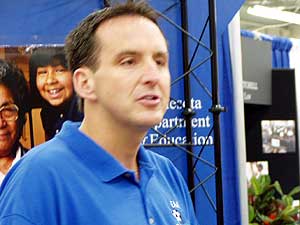|
Audio
Photos
More from MPR
Resources
Your Voice
|
Big increase in number of schools missing No Child goals
August 26, 2004
State education officials have identified 472 Minnesota schools that are not meeting the performance goals required under the federal No Child Left Behind Law. The list of schools released Thursday at the state fair is more than three times longer than last year's.
Falcon Heights, Minn. — This was the first year the state Department of Education evaluated the test proficiency of middle schools and high schools. The number of elementary schools is smaller this time. Gov. Tim Pawlenty says school leaders must move beyond average performance and help those students who aren't succeeding.
 | |||
"On average, Minnesota schools do great. But we all know that we have some pockets of challenge at certain sites or within certain subgroups of students," Pawlenty says. "And they need to be paid greater attention to, and we need to make some additional efforts to make sure those students are also making good progress in our Minnesota schools."
Only schools receiving federal Title I money face sanctions if they remain on the list two or more years. Eight schools were identified for a fourth consecutive year. That means school district officials must come up with a specific plan to turnaround student performance. Seven of those schools are in Minneapolis, and one is in St. Paul.
Another 18 were on for the third year, which requires them to pay for outside tutoring for low-income students. Twenty-two of the schools were listed for the second year, meaning they have to use some of their federal aid to bus kids who transfer to other schools. And 433 made their first appearance, putting them on notice of the need to improve.
Pawlenty and other officials went out of their way to present a softer take on the data, saying the schools shouldn't be considered "failing."
He cautioned people "not to freak out or over-react to the list. It simply means we have to do a better job of making progress for some of the disadvantaged students."
To drive the point home, officials featured principals from once-struggling school that are now in the clear.
|
It's demoralizing. ... It's not optimism for our
students. Instead we're trying to brand our schools as failures.
- State Rep. Mindy Greiling, critic of the rating system |
Rodney Wilson, principal of North End Elementary in St. Paul, said he has tried to encourage more parent involvement and better relationships between students and teachers to improve student performance, but he said "there's no magic bullet except for hard work."
There are two big reasons why this year's list is longer than in 2003: The bar keeps rising every year toward a goal of universal proficiency in reading and math by 2014. Also, middle schools and high schools were assessed on test scores, instead of only attendance and graduation rates.
A year ago, 143 schools missed the No Child Left Behind performance goals. Sixty-four were able to work their way off the list.
Of the schools on Thursday's list, 144 were high schools; 94 middle schools; 124 elementary schools; and 106 alternative learning centers.
Schools can be singled out for low reading and math test scores for the building as a whole or among subgroups broken down by race or English proficiency. They can also get the underachiever label if more than 5 percent of children miss the standardized exams, which is meant to keep schools from manipulating results by only testing the brightest students.
Some administrators say it's unfair to label an entire school because one subgroup fell short.
Education Commissioner Alice Seagren said many schools made the list because special education students or English language learners scored low on tests.
The state's legislative auditor studied the law last year and projected that 80 percent to 100 percent of Minnesota elementary schools will fail to meet the proficiency standards in the next decade.
Critics of the school grading system pounced on the news.
State Rep. Mindy Greiling, DFL-Roseville, said it's another blow to schools that are already dealing with budget problems.
"It's demoralizing," she said. "... It's not optimism for our students. Instead we're trying to brand our schools as failures."
Schools also learned there's a hitch in the state's five-star rating system. Some 800 schools that expected a perfect rating will instead be scored four out of five stars, the St. Paul Pioneer Press reported.
Bill Walsh, a spokesman for the state Department of Education, said the threshold for five stars is higher than districts were told.
The mistake on the star rating system prompted some districts to ask the department to change the ratings to conform to the criteria first reported. Walsh told the Pioneer Press that the agency looked into it, but that would have given 904 schools "exceptional" marks, compared with about 110 schools that will receive the grade under the stricter guidelines.
(The Associated Press contributed to this report)
|
News Headlines
|
Related Subjects
|

